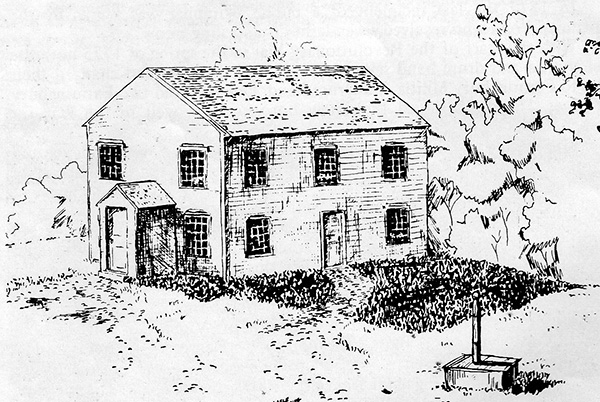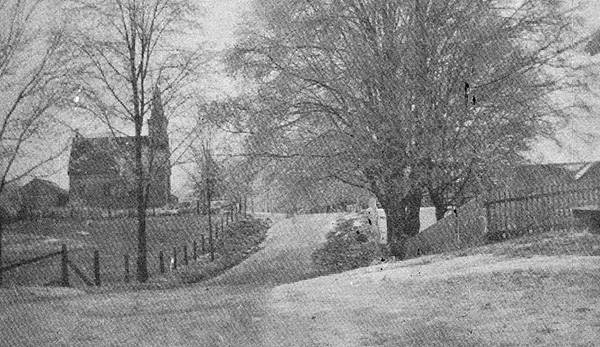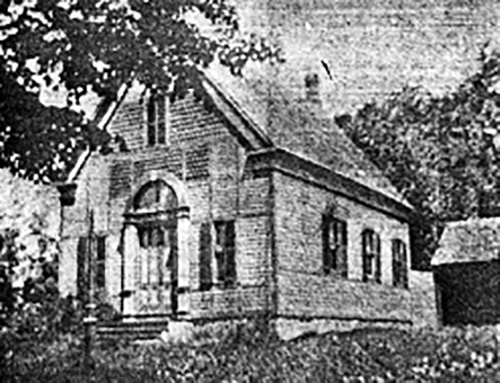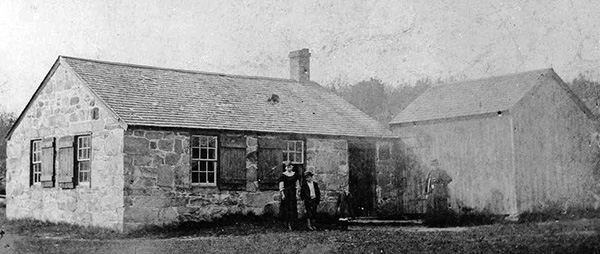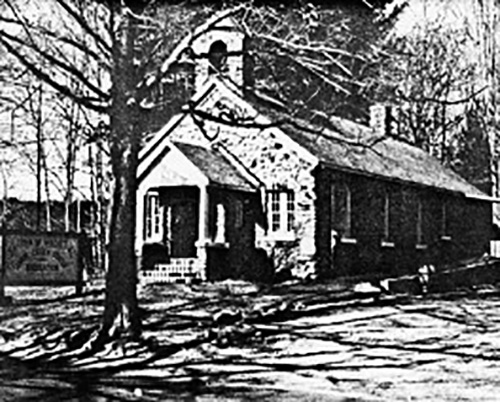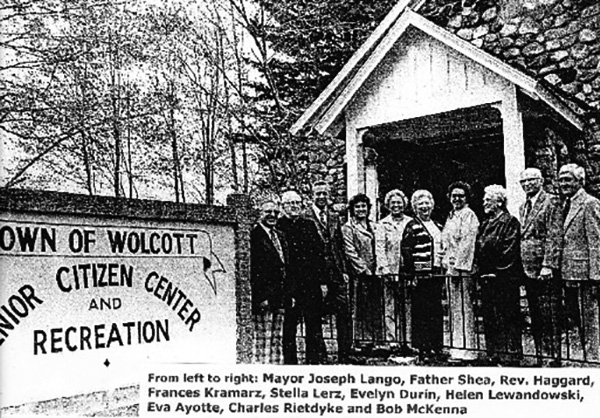|
|
||||||||||||
 |
 |
|
Wolcott Historical Society News - December 2020 By Florence Goodman It's not often that we see snow in October, but that's exactly what happened this year. When all was said and done some areas of town had a dusting while others had four plus inches. The next day as I drove from my home, elevation about 900' to the stone schoolhouse on Nichols Road, elevation about 500' I was shocked to see no snow whatsoever around the museum. This discovery jogged my memory into thoughts of our early settlers and what they endured through those long winter months. That is why they petitioned numerous times to become an independent town citing that traveling overland for substantial distances to attend public worship meetings on the Sabbath was a major hardship. Thus, in1760 the Court agreed to give Farmingbury the services of a minister, operating its own schools and exemption of Waterbury taxes during the five winter months, but it took ten more years before they were given permission to become a separate parish. On November 13, 1770 at the home of Joseph Atkins they held their first meeting of the Ecclesiastical Society. At that time the Congregational parish officers were elected, a tax rate was set, and construction of a meetinghouse was agreed upon. Members of the colonial drum band helped raise the frame of the "Original Meeting House" in April 1772 and by November the first meeting was held in the church atop of Benson's Hill, elevation approximately 800'. So residents traveling from the Woodtick section of town still had many challenges in order to attend church services in those winter months. Think about driving up or down Bound Line Road today in wintry weather then try to imagine what it must have been like 250 years ago in a wagon or buggy. I understand why many of those early residents living in the Woodtick area were delighted when a chapel was built in that part of town. This month I'd like to share the history of the old and new Woodtick Chapel, which today is part of the Charles Rietdyke Senior Center.
In those early years residents of the Woodtick area attended services at the Congregational Church in the Center of town or Mill Plain Union Church in Waterbury. Eventually the Congregational Church minister held Sunday services at the stone schoolhouse (circa 1821) on Nichols Road; as attendance grew the schoolhouse became too small. In 1886, Miss Harriet Juliana Hall donated a half-acre of land to the town to construct a building in the southwest district that would be utilized for church purposes only. She also stipulated that others must donate labor and materials for the construction of such building. The offer was accepted on April 2, 1886 and a chapel committee consisting of Miss Hall, Frederick Upson, David L. Frisbie and Manville A. Norton was appointed. To help raise money for the structure, strawberry festivals were held at the homes of Gustave Cornelis and J. Arthur Bergen and in the fall, produce was exhibited in carts and sold at local fairs. Waterbury merchants and individuals also helped with donations of money and materials.
In the spring of 1886, Charles S. Tuttle and David L. Frisbie dug the building's foundation. By spring of 1887 George Prichard and Mr. Cass started framing the building and with the help of many volunteers they completed the exterior. Although funds were depleted at this point the people still held services in the unfinished building as they continued to work on the interior. Mr. J. Henry Garrigus built the pulpit and Deacon Carter moved Sunday school services from the stone schoolhouse to the Chapel. In 1887, Reverend Woodruff, from the Congregational Church dedicated the new Chapel. It wasn't until several years later that enough funds were raised to completely finish the structure.
Sunday School was held each week at 2:30 and every other week a preaching service was provided by the minister from Congregational Church. Many community activities continued to be held to raise funds to furnish the building. As earlier workers passed away many of their descendants took up the task of maintaining the structure. The faithful members of this Chapel enjoyed many activities in this first wooden structure. Children were baptized there and others were laid to rest from this building and then carried over to the Woodtick Cemetery for burial. In 1890 on New Year's Day, Julia Hadsell Fairclough married Benjamin Holt in this quaint little structure; this was the only wedding to be held in the wooden structure.
Sadly, on April 27, 1924 when Mr. & Mrs. Frisbie were returning home from Sunday morning services at the Congregational Church in the Center of town they noticed a fire near the back of the chapel. They hurried to the home of Mr. & Mrs. Cornelis to call the Waterbury Fire Department while other residents began to help with the fire. Through everyone's quick response, residents were able to save some of the furniture as well as surrounding structures, but the chapel was gone. There was no insurance on the building because Miss Hall always said, "The building is insured in the hands of God." After thirty-eight years of hard work and much community comradery, the chapel was lost, but the fire did not discourage the Woodtick residents. Quoting Mrs. Cornelis, "Of course we are going to build again." On May 6, 1924 a meeting was held at the Wolcott Fair Grounds to discuss rebuilding even with a treasury of only $18.81.
The newly formed rebuilding committee elected Mrs. Cornelis chairwoman with Mrs. Charles Tyrrell and Mrs. Claude V. Badger assisting her. A few years later Mrs. Badger resigned because of poor health so Mrs. Alfred J. German filled the position. The committee did as their predecessors had done and raised money through food and rummage sales, dinners held at fairs, and many other community activities and on September 15, 1924 Mr. Irving C. Miller donated the plans for the new structure. Construction began immediately and continued weather permitting. In 1925 as building funds diminished, Mrs. Cornelis advised borrowing money to complete the exterior of the building; her mother, Mrs. Sarah Browne loaned the committee $1000. By April 10, 1927, the exterior was completed and Reverend Joseph O. Todd, from Mill Plain Church, preached the first sermon in the new structure.
Many parishioners from Mill Plain donated furnishings for the new Chapel. Mrs. Benham donated the organ and Mrs. Raymond Miller, the piano and bench. Mrs. Ned Pritchard donated a large Bible and D.M. Stewart and Son, of Waterbury, donated the pews. Mrs. Emile Cornelis Teller of Wolcott donated many articles including a set of dishes and a sewing machine. Not long after the building was completed Reverend H. Gertrude Coe of Wolcott baptized sixteen children. The first wedding to be held at the new Chapel was in May of 1927 when Miss Alice A. Tyrrell married William A. Dumschatt. Alice was the great, great grandniece of Miss Julia Hall who had donated the land for the original structure. Hard times were finally in the past for the members of the Woodtick Chapel and they were especially blessed in March of 1930 when they realized that Mrs. Gertrude Bradley Walker had left a large sum of money in her estate for the Chapel. When the estate was settled a sum of $3275 was realized. This windfall gave members encouragement to now complete the interior of the Chapel. Mr. William Garrigus and Sons completed the job for a total of $4523.08.
On Sunday, June 25, 1933 Reverend Joseph O. Todd of Mill Plain Union Church dedicated the new Woodtick Chapel with Reverends H. Gertrude Coe and R. Wiley Scott assisting him. Alfred J. German, Chairman of the Trustees, gave the address and welcome. Reverend Coe presented the members with a mahogany plaque in memory of Mr. & Mrs. Gustave Cornelis for their inspiration in the construction of both buildings. The Chapel Committee, Mrs. Gustave Cornelis, Mrs. Charles H. Tyrrell and Mrs. Alfred German were given keys to the Chapel. Mrs. Cornelis was Chairman of the Chapel Committee from 1924 to 1949 and Mrs. Charles H. Tyrrell took over the chairman's job after 1949.
In May of 1955, Nellie Ames Browne left $300 to the Chapel Society and Charles D. Winters of Todd Road donated the weathervane for the building. During the summer months Church School was held in the Chapel for several years and in later years the Pentecostal Church and the Wolcott Community Church held weekly services there until they built their own churches. The All Saints Episcopal Church also used the Chapel until they built their new church at the Center of town in 1964. The church was used for Baptist Church services after that.
The Wolcott Senior Center moved into the Chapel in 1964. There was a small kitchen and meals were served from it. The building was also used by local organizations for meetings and by the Recreation Committee. In 1971 it served as the Headquarters for the 175 Anniversary Committee. In time the town added a portable classroom from one of the schools to enlarge the Center. This structure was placed next to the stone chapel and connected by a walkway. Around 1976, (I'm not sure of the exact date) the Center was renamed for Charles Rietdyke, a former First Selectman and a strong advocate for seniors. In 2001 with funds from a State Grant construction on the new Charles Rietdyke Senior Center began. On July 5, 2002 the Dedication Ceremony was held for the new and improved Senior Center. Today the center is used daily for breakfast, lunches and a variety of social activities for senior citizens from Wolcott and surrounding towns. Our residents are fortunate to have such a wonderful place for our seniors to meet.
(Information for this article was taken from The 175th Anniversary Booklet 1796-1971 by John Washburne, The Meeting House Atop of Benson's Hill> by John Washburne; >History of the Old and New Woodtick Chapel> by Mrs. Charles H. Tyrrell; a 2010 interview with Marie Trerice; and the January 2010 Wolcott News article by Florence Goodman)
Original Meeting House - Etching by Lisle Fleming
Old Woodtick Chapel- March 1898 - taken from the middle of Nichols Road at the entrance to Recreation area.
Old Woodtick Chapel - Built 1887
Old Stone Schoolhouse - Prior to 1898 before addition
Stone Chapel as Senior Center before portable was added.
Senior Center Committee - Circa 1976
To view past installments of the Historical Society News, click here. |
|
|
[Home]
[News]
[Purpose]
[Calendar]
[Museum]
[Membership]
[History]
[Contacts]
[Links]
All material at Wolcott Historical Society Web sites Copyright © 2000-2020 Wolcott Historical Society |
